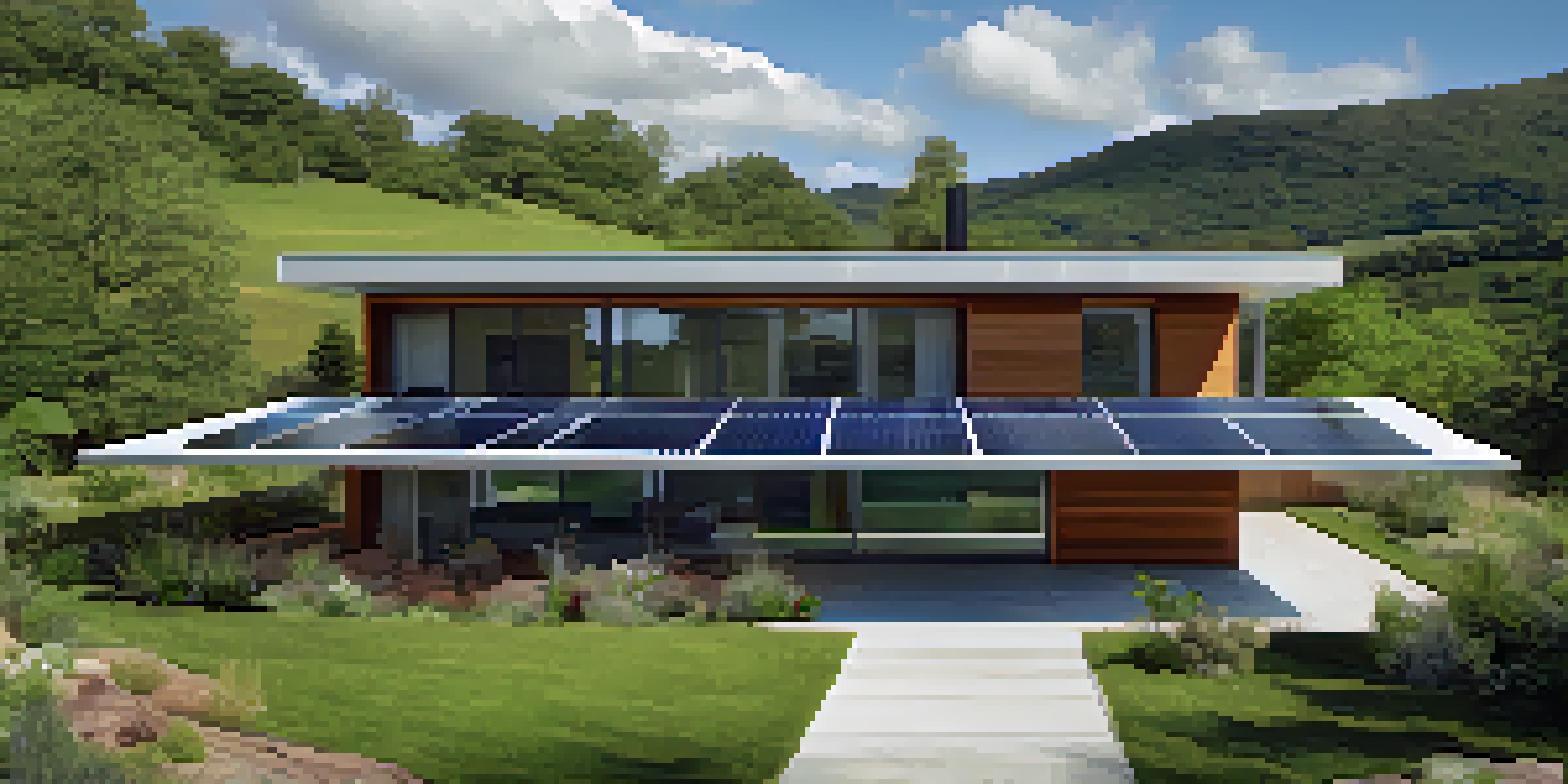Designing Homes to Withstand Climate Change

Understanding Climate Change Impacts on Homes
Climate change is causing more extreme weather events, from heavy rainfall to scorching heatwaves. These changes can significantly affect the safety and durability of our homes. For instance, homes in flood-prone areas are at greater risk of damage as sea levels rise and storms become more intense. Understanding these impacts helps homeowners and builders make informed decisions on design and materials.
The best way to predict the future is to create it.
The goal is to create a living space that not only withstands the elements but also provides comfort and security. By identifying local climate risks, we can tailor our designs to mitigate them. For example, homes in wildfire-prone areas may benefit from fire-resistant materials and landscaping. Awareness of these threats is the first step toward resilient home design.
Ultimately, designing with climate change in mind is about future-proofing our homes. It’s not just a trend but a necessary shift in how we think about residential architecture. As we adapt to these new realities, we ensure that our homes are safe havens for generations to come.
Selecting Sustainable Building Materials
Sustainable building materials are crucial for homes designed to endure climate change. These materials are not only environmentally friendly but also often more resilient to weather-related wear and tear. For example, bamboo is a renewable resource that can withstand moisture and pests better than traditional wood. Choosing the right materials can significantly enhance the durability of a home.

Moreover, utilizing recycled or reclaimed materials can reduce the carbon footprint of construction. This practice not only lessens waste but also adds character to a home. Imagine a beautiful feature wall made from reclaimed wood that tells a story while contributing to sustainability. It's a win-win situation for both the environment and aesthetics.
Design Homes for Climate Resilience
Incorporating features like fire-resistant materials and elevated structures can help homes withstand extreme weather events.
Incorporating local materials can also minimize transportation emissions, further enhancing sustainability. For instance, using stone or clay from nearby quarries not only supports local economies but also ensures that your home is well-suited to its environment. Overall, careful material selection is a cornerstone in designing homes that can weather the changing climate.
Incorporating Energy-Efficient Design Features
Energy efficiency is a key component in designing homes that combat climate change. By incorporating features such as high-quality insulation, energy-efficient windows, and smart thermostats, homeowners can significantly reduce their energy consumption. For example, triple-glazed windows can keep the heat in during winter while keeping the heat out in summer, leading to lower utility bills.
We do not inherit the earth from our ancestors; we borrow it from our children.
Additionally, the orientation of a home plays a vital role in its energy efficiency. Positioning windows to maximize natural light reduces the need for artificial lighting, while overhangs can minimize heat gain in the summer. This thoughtful design not only enhances comfort but also aligns with sustainable living practices.
Beyond comfort and cost savings, energy-efficient homes contribute to a healthier planet. By reducing reliance on fossil fuels, homeowners can lower their carbon footprint and contribute to the fight against climate change. Every small change counts, and energy-efficient design is a powerful tool in this collective effort.
Utilizing Renewable Energy Sources
The integration of renewable energy sources is a game-changer in designing homes that withstand climate change. Solar panels, for instance, have become increasingly accessible and can significantly reduce electricity costs while providing a clean energy alternative. Imagine producing your own energy and even selling excess power back to the grid—it's a sustainable dream come true.
Wind turbines are another option, particularly for homes in breezy areas. Small-scale turbines can generate enough energy to power a household, reducing dependence on traditional energy sources. This not only minimizes utility bills but also helps homes become more self-sufficient and less vulnerable to energy price fluctuations.
Select Sustainable Materials
Using renewable and locally sourced materials enhances durability while reducing a home's carbon footprint.
Moreover, using energy storage systems, such as batteries, allows homeowners to store excess energy for use during peak times or outages. This adds an extra layer of resilience, ensuring that your home remains powered even during extreme weather events. Embracing renewable energy is not just a trend; it’s a necessary step toward a sustainable future.
Implementing Effective Water Management Systems
Water management is becoming increasingly vital as climate change leads to unpredictable rainfall patterns. Implementing systems like rainwater harvesting can help homeowners collect and use rainwater for irrigation or even indoor use. This sustainable practice not only reduces water bills but also lessens the strain on local water supplies during droughts.
Additionally, creating permeable surfaces in landscaping can allow rainwater to seep into the ground rather than run off, reducing flooding risks. For example, using permeable paving stones instead of traditional concrete can help manage stormwater effectively. This simple change can protect a home's foundation and the surrounding environment.
Lastly, incorporating greywater recycling systems can maximize water use efficiency within the home. These systems reuse water from sinks and showers for irrigation, further conserving water resources. By implementing effective water management strategies, homeowners can protect their properties while contributing to broader environmental sustainability.
Designing for Natural Disaster Resilience
Designing homes to withstand natural disasters is crucial in an era of climate change. This means considering factors like seismic activity, flooding, hurricanes, and wildfires when planning a build. For example, elevating a home in a flood-prone area can prevent water damage during heavy rains, while using fire-resistant materials can protect against wildfires.
Architectural features play a significant role in enhancing resilience. For instance, rounded edges and aerodynamic shapes can reduce wind resistance, making homes more stable during storms. Similarly, using reinforced concrete can provide added strength against seismic movements. The right design choices can mean the difference between a home standing strong or succumbing to nature's fury.
Community Efforts Enhance Resilience
Collaborative community initiatives, such as shared gardens and renewable energy sources, strengthen local climate resilience.
Ultimately, disaster-resilient design is about foresight and preparation. By investing in features that enhance a home's ability to withstand extreme events, homeowners are not just protecting their investment; they are safeguarding their families and communities. It's a proactive approach that pays off in peace of mind.
Creating Flexible and Adaptable Spaces
As climate change continues to evolve, so too should our homes. Designing flexible and adaptable spaces allows homeowners to adjust their living environments to meet changing needs. For example, movable walls can create multi-functional rooms that serve different purposes at different times, maximizing the use of space.
Additionally, incorporating features like retractable awnings or modular furniture can help homeowners respond to varying weather conditions. On a hot summer day, an awning can provide shade, while during cooler months, it can be retracted to let in sunlight. This adaptability not only enhances comfort but also extends the life of the materials used.

Ultimately, creating flexible spaces is about embracing change. As our lifestyles and climate conditions shift, so can our homes, ensuring they remain functional and enjoyable. This forward-thinking approach fosters resilience and encourages a more sustainable way of living.
The Importance of Community in Climate-Resilient Living
Designing climate-resilient homes isn't just an individual effort; it's a community endeavor. Neighborhoods that work together can implement shared sustainability practices, such as community gardens or shared renewable energy sources. This collective approach not only strengthens bonds but also enhances the overall resilience of the area against climate-related challenges.
Community planning plays a crucial role in adapting to climate change. By designing neighborhoods with green spaces, efficient public transport, and accessible resources, we create environments that support sustainable living. For instance, having local farmers' markets can reduce the carbon footprint associated with food transportation while fostering community spirit.
Moreover, engaging in community discussions about climate issues can lead to innovative solutions tailored to local needs. When residents come together to share ideas and resources, they empower one another to take action. Ultimately, community collaboration is a powerful tool for creating a more sustainable and resilient future.